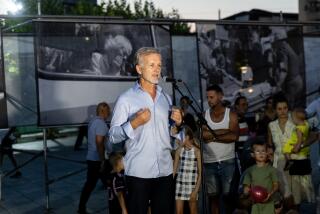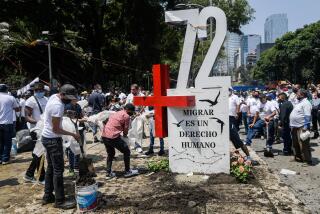Thousands of Argentines Honor Slain Photographer
PINAMAR, Argentina — Indignant and mournful crowds Sunday honored the memory of magazine photographer Jose Luis Cabezas, whose killing in this exclusive beach resort a year ago brought down a Cabinet minister and police commanders and cast a cloud of suspicion over a politically connected tycoon.
After driving from Buenos Aires to Pinamar, a caravan of hundreds of journalists joined politicians and thousands of spectators at a rally where they released clusters of black balloons and demanded justice.
“We will only relent when we are sure that all of the guilty have been captured,” said Gabriel Michi, a co-worker at Noticias magazine who was with Cabezas minutes before the photographer’s abduction and slaying a year ago. “When we can tell Cabezas’ children that their father can rest in peace because those who committed and covered up the crime are in jail.”
The unsolved case has become a regional cause celebre. Rallies, church services, television specials and a national moment of silence recalled Cabezas’ death at the hands of a paramilitary gang of abductors, who shot the handcuffed 35-year-old and set his car ablaze with the body inside.
Expressing mixed emotions about the outpouring of protest, editor Hector D’Amico of Noticias said it is good that people keep the memory alive. But D’Amico, who has been a dignified voice of outrage and led a Noticias investigation that unearthed important leads into the killing, also said he worries that some of the hoopla--a celebrity hairstylist wanted to stage a fashion show with a Cabezas theme--could politicize and trivialize the case.
“Marches are useful, but they will not solve the crime,” D’Amico said. “There is a danger that this could become just a media event.”
Many Argentines wonder whether they will ever learn the truth about the first killing of a journalist since the return of democracy in 1983. Authorities have jailed a gang of petty criminals and police officers and the alleged mastermind, the security chief of Alfredo Yabran, a postal magnate. Yabran has not been charged, but he remains under investigation.
The case opened a door into a hazy underworld that, analysts say, combines sectors of today’s economic and political elite with thuggish forces rooted in the police and military of Argentina’s repressive 1976-1983 “dirty war,” when the dictatorship killed scores of journalists.
“The murder of Cabezas had an exponential number of consequences,” said lawmaker Juan Pablo Cafiero, a member of a congressional anti-corruption commission. “This crime revealed the weakness of the political and justice systems, the crisis of impunity in Argentina. The nation has to resolve its problems with the security forces and build a credible justice system.”
Cafiero and other opposition politicians accuse Yabran of being an organized-crime boss who controls postal services, airports, government officials and private security companies that employ notorious military and law enforcement veterans of the dirty war.
But the ruling party majority on the anti-corruption commission issued a report in November, over the dissent of the opposition, finding insufficient proof to conclude that Yabran used mafia-style tactics to build a secretive business empire.
A poll published Friday by the newspaper Pagina 12 found that 30% of Argentines suspect Yabran of ordering the killing, while 26% suspect his entourage. Yabran, however, denies any role in Cabezas’ death and says political rivals are trying to destroy him.
Other leaders have backed him. After the justice minister resigned in June because phone records contradicted his claim that he did not know Yabran, President Carlos Menem’s Cabinet chief took the unusual, much-criticized step of receiving the magnate in the presidential palace.
The charges against Yabran’s security chief raise obvious questions about whether the jailed bodyguard acted alone or under orders. Investigators have pursued a web of connections, including suspicious phone calls and meetings involving Yabran’s security men and the accused triggerman, one of a band of allegedly corrupt cops.
Moreover, Yabran admitted to meeting with the suspected killer weeks before the crime, though the executive testified that it was merely a Christmas courtesy visit. And court psychiatrists testified that the accused gunman admitted that Yabran hired him to give the photographer a scare.
But the evidence remains circumstantial. There are fundamental doubts: The first autopsy overlooked a bullet wound. The murder weapon inexplicably turned up in the home of a suspect who has been cleared. Witness accounts change frequently amid accusations on both sides of bribery and intimidation.
Yabran told investigators that he was not bothered by Cabezas’ photos of him, the first ever published here, and authorities have yet to fully explain their theory of the motive. But many suspect it was retaliation for exposes by Noticias magazine.
Yabran security guards had been accused of violently confronting journalists in the past. During the last days of his life, Cabezas told a friend that he feared retaliation from Yabran, whom he was shadowing for the magazine, according to testimony in the case.
“I think the motive has to do with Cabezas’ work,” said Oscar Pellicori, a lawyer for the victim’s family. “The insistent journalistic persecution was the straw that broke the camel’s back. I don’t know if the killing was premeditated or began as an attempt to intimidate or assault him and escalated from there.”
The investigating magistrate is expected to send the 10 jailed suspects to trial soon in hopes that answers will emerge in court.
More to Read
Sign up for Essential California
The most important California stories and recommendations in your inbox every morning.
You may occasionally receive promotional content from the Los Angeles Times.










